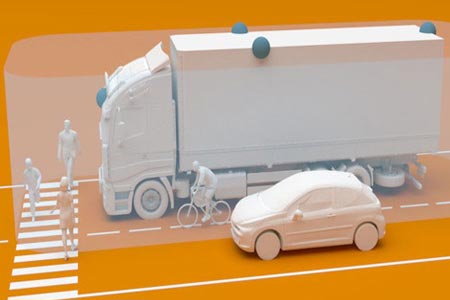In 1961, the very first tonal beeping reversing alarm was manufactured in Japan, and quickly proved to be a game changer in terms of accident prevention. More than 50 years later, the safety of road users and construction site workers who share space with semi-trucks and other commercial vehicles is still of paramount importance.
Research has found that 25% of all deaths in the workplace are caused by reversing vehicles. Ongoing research is therefore vital to help prevent lives being lost. These days, ever more sophisticated technology is being introduced by safety experts to address this issue and save lives.
Raising the alarm
By the 1970s tonal alarms were being fitted on many semi-trucks and construction site machinery across the world, significantly reducing the number of accidents caused by vehicles reversing.
Problems soon occurred, critics complained about the noise nuisance, pointing to the long distances at which alarms could be heard; and it became increasingly clear that on construction sites, the sound of the alarms could be confused with noise from other machinery. It was also difficult to tell from which direction the alarm was coming from.
Following research carried out by Brigade Electronics, a white noise multi-frequency alarm was developed in the early 2000s, emitting a 'shh-shh' sound rather than 'beep-beep'. Multi-frequency white sound alarms are easier on the ear as well as being safer, using broadband frequencies to make the location of the alarm source obvious.
Rise of the camera
Meanwhile, in the late 1990s, on-board cameras began to be fitted to vehicles to help give drivers a comprehensive view of what was going on outside their vehicle, especially areas not covered by mirrors. This followed a crop of high-profile insurance pay-outs concerning reversing accidents. The original systems were in essence CCTV, requiring the driver to look at multiple screens at once while carrying out tricky maneuvering in an often-bulky vehicle.
Today's on-board cameras utilize the latest software to create intelligent systems which provide the driver with a complete surround view of the vehicle in real time. Brigade's best-selling Backeye®360, for example, features four ultra-wide cameras to capture footage of surroundings simultaneously, eliminating the need to monitor several mirrors or screens at once.
Putting safety on the radar
The first radar warning systems were produced in the US as early as the late 1950s, but it wasn't until the 1990s that they were manufactured for commercial use.
Radars complete the vehicle safety picture, detecting people and objects in a driver's blind spot, not covered by mirrors. Visual and audible warnings warn the driver when stationary or moving objects have been detected, and the systems work effectively even in harsh environments such as darkness, fog and smoke. These warning systems are particularly important for improving the safety of vulnerable road users, such as cyclists and pedestrians, as well as construction workers on busy work sites.
For more details, visit: https://brigade-electronics.com/



